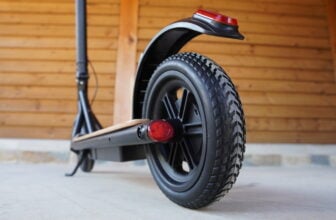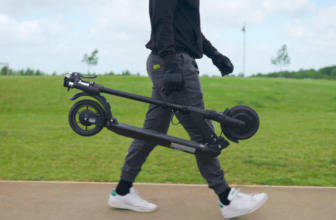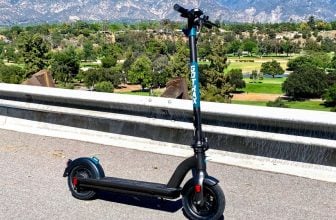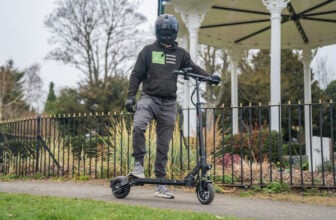4 Best Electric Scooters for College Students & Campus Life (24 Models Tested)
Top Picks: Best Electric Scooters for College Students
To find the 4 best electric scooters for college, I tested a total of 24 affordable models that all cost less than $1,000. I then divided the scooters into three price categories to accommodate different budgets.
To make my selection I assessed each scooter’s performance across various tests.
Here, I completed top speed, acceleration, range, hill climbing, braking, and ride quality tests to identify the models that represented the best value for money.
I also assessed their practicality for college campuses by reporting on how portable and reliable they were for carrying and storing in dorms/classes and withstanding the wear and tear of everyday use.
I even gave some of the scooters to a close friend who attended California Lutheran University to gain additional insight into their suitability.




Best By Type: Electric Scooters By Use Case
Heavy Riders
- VMAX VX2 Pro – Supports riders up to 287 lbs
Further Information:
Heavy Duty Electric Scooters for Heavy Adults
Tall Riders
- VMAX VX5 Pro – Suitable for riders up to 6'3″
Further Information:
Electric Scooters for Tall Adults
Fastest
- Apollo Go – 25.5 mph tested top speed
Further Information:
Fastest Electric Scooters
Longest Range
- VMAX VX2 Pro – 28 miles max (24.8 miles real-world tested range)
Further Information:
Long Range Electric Scooters
Off-Roading
- None
Further Information:
Best Off-Road Electric Scooters for All Types of Terrain
Biggest Wheels
- VMAX VX2 Pro – 10 inches
Further Information:
Big Wheel Electric Scooters
Lightest
- Turboant M10 Lite – 30.9 lbs
Further Information:
Lightweight Electric Scooters
Portable, Compact & Small Electric Scooters
Most Compact & Portable
- VMAX VX5 Pro – Takes seconds to fold and weighs just 36.8 lbs
Further Information:
Lightweight Electric Scooters
Portable, Compact & Small Electric Scooters
Commuting
Further Information:
Best Electric Scooters For Commuting
Hill Climbing
- Apollo Go – Moderate inclines
Further Information:
Electric Scooters For Climbing Hills: Breeze Up the Steepest of Inclines
Suspension
- Apollo Go – Front spring and rear rubber block, scores 6/10 on my shock absorption scale
Further Information:
Electric Scooters With Suspension: 5 Buttery-Smooth Rides
Waterproof
- VMAX VX5 Pro – IPX6 water-resistance rating
Further Information:
Waterproof Electric Scooters: Best Scooters For Riding in the Rain
Seated
- None
Further Information:
Best Electric Scooters With Seats (Detachable & Built-in)
Scooter Finder
Filter, compare, and sort through all of the electric scooters for college.
Scooter Finder
Filter, compare, and sort through all of the electric scooters for college.
Best Basic Budget For Campus Cruising
Turboant M10 Lite
Performance Report:
Tester: Josh Frisby (190 lbs, 6.1 ft)
- Top Speed: 16 mph
- Real Speed: 15.8 mph*
- 0-15 mph: 7.8 s*
- Max Range: 15.5 miles
- Real Range: 10 miles*
- Braking: 2.9 meters*
- Max Incline: 15 degrees
- Optimal Incline: 7 degrees*
- Weight: 31 lbs
- Load: 220 lbs
The Good:
- Outstanding value for money
- Chart-topping performance in the sub $400 category
- Ride and build quality are impressive
- Dual-braking system is strong
- Clean and tidy cable management
- USB charging port that works
- Super quick and easy folding mechanism
- Anti-glare display
- Long fenders prevent splashback
- IP54 water-resistance rating
The Bad:
- Deck is a little short
- Cruise control has a habit of kicking in uninvited
- Taillights could be more visible from behind
Why I Recommend the Turboant M10 Lite:
Campus can often feel like part catwalk, part obstacle course. You’ll therefore want a scooter that’s both stylish and practical. Well, the good news is that the Turboant M10 Lite exists – and it costs less than $300.

Featuring a simple, yet sleek matte-black finish, efficient folding mechanism, and best-in-class performance metrics, it’s pushed the dial on what students can expect from a budget scooter.

You see, while the M10 Lite is cut from the same cloth as the rest of the extremely popular Turboant line, it manages to bring a clutch of crucial refinements to elevate its appeal among the rest of its similarly-priced competitors.

The first noteworthy area of performance is its top speed. Sporting a 36V 350W motor, it can hit a snappy 15.8 mph and get there from a standing start in 7.8 seconds. This is fast enough to zip around campus while remaining safe.

Yet, where the M10 Lite really shines is in its range. Under my tests, its 6.6Ah battery kept the wheels rolling for 10 miles. This beats the 8.7-mile average of the other sub-$350 scooters that I’ve reviewed.

It also performs admirably in the braking department. Wielding a rear disc and an electronic braking system, it brought me to a safe stop from 15 mph in 2.9 meters. Again, against the backdrop of its most fierce rivals, this constitutes a 38% shorter stopping distance.
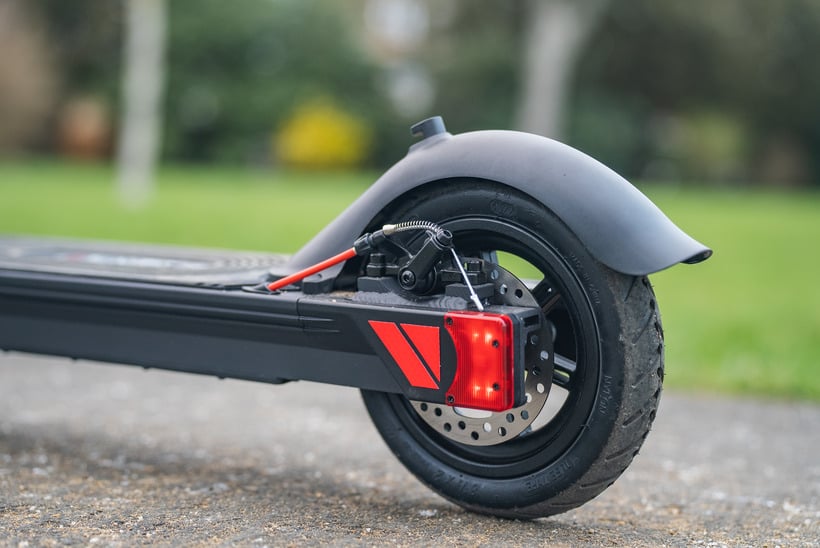
Of course, you’ll also want your scooter to be comfortable. Well, though the M10 Lite doesn’t come with suspension (for its price this is expected), its 8.5-inch pneumatic tires cushion most shocks and vibrations so long as you stick to well-maintained roads. Their smaller profile also means that the M10 Lite remains nimble, which proves valuable when navigating busy environments.

Its nimble nature is aided by its wide handlebars and ergonomic cockpit. Grippy rubber handgrips make steering effortless, while the thumb throttle is smooth and within easy reach. There’s even a USB charging port below the display, which allows you to re-juice your phone on the go. Out of all the scooters that I’ve reviewed, no other budget model offers this feature.

Another feature worth mentioning is its 3-step folding mechanism. To fold the scooter, you rotate the safety catch to free the lever, pull it down, lower the stem, and latch the handlebars to the rear fender. While this is super easy, I did find that the stem occasionally came loose from the latch, meaning I had to reattach it before attempting to pick the scooter up.

Nevertheless, once folded, the M10 Lite has a small enough profile to fit in a car trunk or under your desk with minimal fuss.
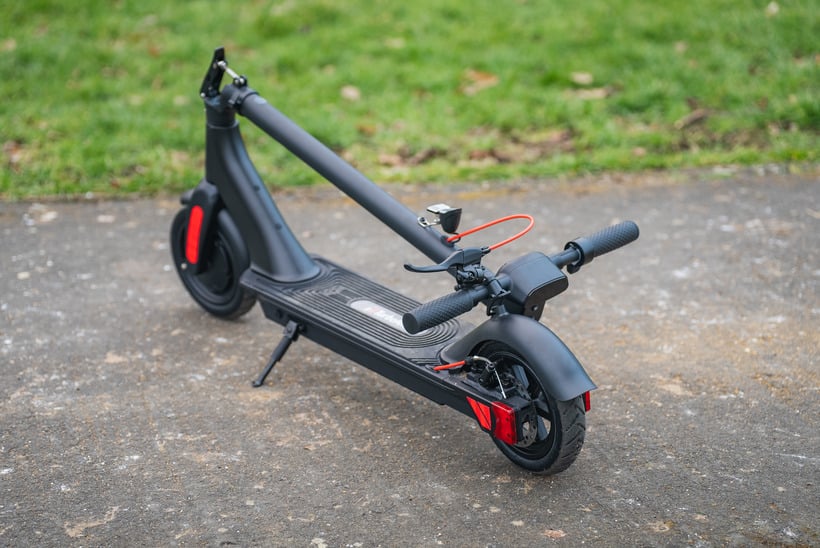
And, despite it being one of the lightest scooters that I’ve ever tested, it still manages to remain durable. It can take a few knocks and bumps in its stride, while its frame is also protected by an IP54 water resistance rating. This ensures that it’s protected against light showers and puddle splashes.

If I had to pick one area where the M10 Lite comes up a little short, it would be the size of its deck. Measuring just 17.7 inches in length it's around 2 to 4 inches shorter than a typical budget scooter. It’s also only capable of supporting up to 220 lbs. If you have big feet and are heavier on the scale, then I recommend checking out the VMAX VX5 Pro.

Ultimately, though, with all that the Turboant M10 Lite has to offer, it serves as an excellent choice for students who are on a tight budget.

Best All-Around & Overall Value
VMAX VX5 Pro ST
Performance Report:
Tester: Josh Frisby (190 lbs, 6.1 ft)
- Top Speed: 18 mph
- Real Speed: 17.4 mph*
- 0-15 mph: 6.7 s*
- Max Range: 17 miles
- Real Range: 14.3 miles*
- Braking: 2.0 meters*
- Max Incline: 14 degrees
- Optimal Incline: 8 degrees*
- Weight: 35.9 lbs
- Load: 265 lbs
The Good:
- One of the longest real-world tested ranges in its price category
- Shortest stopping distance among its rivals
- Top-tier ride quality in the sub-$600 class
- Wider than normal handlebars promote good handling
- Regenerative braking system recycles kinetic energy to recharge the battery on the go
- High degree of build quality with a UL2272 certified battery
- Clean, simple, and functional design
- Grippy, nimble tires
- Immaculate cable management
- Turn signals that are visible from the front, rear, and sides
- Mobile app allows for customized performance
- Slick folding mechanism
- 40.2-inch deck-to-handlebar height makes it suitable for tall riders up to 6’3”
- Protective IPX6 water-resistance rating
- Long fenders that prevent splashback
- Quiet motor
- Low maintenance
- 2-year warranty
The Bad:
- Display gets washed out in direct light
- The taillight is bright at night, but it doesn’t flash when you brake - it just glows a brighter red
Why I Recommend the VMAX VX5 Pro ST:
Any college student navigating the hustle and bustle of campus life requires a scooter that’s in essence a Swiss army knife on wheels – in other words, it needs to be a model that does everything well. It’s no coincidence that the VMAX VX5 Pro ST hails from the same lands as its all-purpose inspiration.

This award-winning, all-singing workhorse has set tongues wagging in the budget everyday market thanks to its solid performance profile, exceptional build quality, comfortable ride, and reliable design. It’s plush and practical, exciting and economical, and refined and robust.

But, best of all, for students who need to watch their pennies, the VX5 Pro ST remains affordable. This is serious bang for your buck that, frankly, puts its competition to shame. In fact, I rate it as the most well-rounded budget electric scooter that I’ve ever reviewed.
Firstly, there’s its lengthy range. Armed with a 36V 7.8Ah ST battery, the Pro can muster a maximum range of 17 miles on a single charge. You can also purchase it in 2 other variants – the LT and GT – with cheaper and smaller batteries if money is tight.

The real clincher, however, is its real-world mileage. Ordinarily, an electric scooter achieves around 60-70% of its maximum when factors like rider weight, speed, and topography enter the equation; yet under my tests, the Pro’s real-world range of 14.3 miles stands at 84%, placing it head and shoulders above the rest. This is great news for students who have to commute to or across campus to get to class.

As for motor power, the VX5 Pro hits the sweet spot between fun and steady. I tested its top speed at 17.4 mph, while its acceleration rate of 0-15 mph in 6.7 seconds brings the fun factor while guaranteeing control.

You needn’t worry about the Pro’s ability to handle the unpredictability of everyday weather, either. Its IPX6 water resistance rating ensures that it can withstand sudden showers without fear of damage, while a pair of long fenders protect your clothes from splashback.

Meanwhile, its 9-inch tires sport a wavy tread pattern that maximizes grip on wet surfaces and tight corners. Against the backdrop of competing scooters, I found that the tires on the VX5 Po elevated its overall handling above the rest.

The same can be said for the handlebars which, by my measurements, stretch 21.9 inches. This makes them a whopping 33% wider than those on the Turboant X7 Max. Couple with the extremely tactile handgrips, smooth throttle, and easy-to-use rocker switch for the turn signals, it sets the standard not only for ergonomics but control, too.

In fact, the VX5 Pro has been expertly designed from top to bottom, with longevity and ride quality in mind. This becomes immediately apparent when you compare its design to rival scooters. While many budget brands buy prebuilt scooters from various manufacturers and slap their logos on the frames, VMAX owns their manufacturing facility. This means you get a unique scooter with a proprietary build, design, and feature set.

Unsurprisingly, it ticks the safety box, too. Not only is the battery UL2272 certified, meaning it’s passed several tests for fire safety and electrical hazards, but with an extremely strong front drum and accompanying rear regen brake, it brought me to a stop from 15 mph in just 2.0 meters. This trumps many scooters that retail at triple its price. You can also use the regenerative system independently; in doing so, you can recharge your battery on the go.

The strength of the regen brake, as well as your acceleration, can be adjusted via the nifty mobile app, too. This also allows you to lock and unlock the scooter, turn the lights on and off, toggle between sport and eco modes, and select kick-to-start or zero-start mode.

For a scooter of the VX5 Pro’s price, having a mobile app is incredibly rare. Yet, this isn’t the only trick up its sleeve. To my surprise, you can rely on it to get around campus after dark. The high-mounted headlight is bright enough for night rides, while its turn signals can be seen from all angles thanks to their positioning on the handlebars and deck.

Portability is another area of strength. It passed my tests in this department with flying colors. Its slick folding lever and hook-and-latch system made collapsing the stem super easy, while its 35.9 lbs folded frame was light enough to carry.

In summary, the VMAX VX5 Pro ST is tailor-made for student life. Affordable yet oozing with quality and durability, it brings all the best of all three worlds into one complete package. Plus, with a 2-year warranty that’s, on average, double the length of rival scooters, VMAX stands out as the most reliable budget brand on the market.

Best Long-Range Commuter for Daily Rides
VMAX VX2 Pro ST
Performance Report:
Tester: Josh Frisby (190 lbs, 6.1 ft)
- Top Speed: 24 mph
- Real Speed: 24.5 mph*
- 0-15 mph: 3.8 s*
- Max Range: 28 miles
- Real Range: 24.8 miles*
- Braking: 3.0 meters*
- Max Incline: 15 degrees
- Optimal Incline: 9 degrees*
- Weight: 45 lbs
- Load: 287 lbs
The Good:
- Fastest acceleration among similarly priced single-motor scooters
- Longest tested range in the sub-$900 class
- Strong brakes that use a regenerative system to recycle kinetic energy to recharge the battery on the go
- Exceptionally quiet motor
- Impeccable build quality
- Nimble tubeless tires
- Suitable for tall and heavy riders
- Bright lights with excellent turn signals that are visible from the front, rear, and sides
- Mobile app allows for customized performance
- Slick folding mechanism
- Tidy cable management
- Protective IPX6 water-resistance rating
- Long fenders that prevent splashback
- Low maintenance
- 2-year warranty
The Bad:
- Doesn’t have suspension
- Display gets washed out in direct light
- The taillight is bright at night, but it doesn’t flash when you brake - it just glows a brighter red
Why I Recommend the VMAX VX2 Pro ST:
If you're a student with a long commute or a large campus to cover, the VMAX VX2 Pro ST is a game-changer. With a real-world tested range of 24.8 miles, it outperforms every other scooter in its price class.

But it’s not just about going the distance. Built with Swiss precision, this scooter is packed with thoughtful design details that make a difference in daily college life. Its wide handlebars, spacious deck, and ergonomic geometry offer comfort and stability for taller riders (up to 6'2″). Plus, with a 287 lb load capacity, it’s one of the most inclusive scooters on this list.

It ticks the portability box, too. Thanks to a super-easy folding lever, it takes mere seconds to collapse. Once the stem’s been folded, a spring-loaded latch on the back of the handlebars snaps onto the hook that protrudes from the fender. Once connected, it’s easy to carry for short stints up flights of stairs and into class.

It doesn’t hold back performance-wise, either. Powered by a 48V 500W motor with a peak power output of 1300W, I reached a top speed of 24.5 mph and accelerated from 0-15 mph in just 3.8 seconds. This is 51% faster off the line than the Turboant M10 Lite, and beats its sibling, the VX5 Pro, by 2.9 seconds.

Braking is just as impressive. Its front drum and rear regen brake combo brought me to a full stop from 15 mph in only 3.0 meters. You can even fine-tune the regen braking strength using the mobile app, which also gives you control over your acceleration, speed modes, and lights.

On the topic of the lights, another standout feature is the integrated turn signals. Built into the ends of the handlebars and at the rear of the deck, they remain visible from every angle. They’ve also been much better designed than the turn signals on the Apollo Air, Go, City, and Pro. Instead of brittle plastic caps, the VX2 wraps rubber around the casings to protect them. With Apollo’s models, I knocked a couple of them over, and the turn signals immediately smashed. With the VX2, there were no such issues.

This durability extends to the VX2’s IPX6 water resistance rating. With this in tow, it can withstand heavy downpours, making it suitable for riding across campus in the rain. Plus, with elongated fenders that smother the tires, splashback is avoided.

Beyond the VX2’s impressive credentials, there’s still room for improvement – after all, no scooter is perfect. One blemish is the absence of a suspension system. However, the 10-inch pneumatic tires serve up a cushioned ride by absorbing the majority of shocks and vibrations. If suspension is important to you, then I recommend checking out the Apollo Go.

Yet, beyond this minor drawback, there’s no denying the value on offer, and no where is this made more evident than from its two-year warranty. Not only is this among the best in the industry, but VMAX takes care of all the costs related to shipping. This is incredibly rare, with almost all other retailers and brands charging you for shipping fees related to any warranty claims. For students on a budget this can’t be overlooked.

In short, the VX2 Pro ST blends exceptional range, reliable performance, and refined design into a daily ride that’s more than ready for student life.

Most Reliable, Low-Maintenance & Feature-Rich
Apollo Go
Performance Report:
Tester: Josh Frisby (197 lbs, 6.1 ft)
- Top Speed: 28 mph
- Real Speed: 25.5 mph*
- 0-15 mph: 3.8 s*
- Max Range: 30 miles
- Real Range: 17.6 miles*
- Braking: 3.1 meters*
- Suspension: 6/10*
- Max Incline: 25 degrees
- Optimal Incline: 12 degrees*
- Weight: 46 lbs
- Load: 265 lbs
The Good:
- Ultra-sleek design
- Premium build quality
- Packed full of useful features
- Cybertruck-inspired lights
- Handlebar integrated turn signals
- Well-designed geometry delivers intuitive control and handling
- Best-in-class cockpit ergonomics
- DOT Matrix display is extremely bright and easy to read from any angle
- Comes with a free QuadLock phone case accessory (saving you $30)
- Integrated mobile app for customized performance
- Stable and nimble thanks to its 14-degree rake angle
- Reliable self-healing tires
- A regenerative braking system recycles kinetic energy to recharge the battery by up to 10%
- A 40-inch deck-to-handlebar height and 265 lb load-bearing capacity make it well-suited to tall and heavy riders
- Impeccable cable management
- Extremely low maintenance
- Battery management system ensures long-term health
- Protective IP66 water-resistance rating
The Bad:
- The plastic caps that encapsulate the turn signals are prone to damage
- The taillight is dim during the day
- The clip-in, clip-out folding hook system is a little fiddly
- The handlebars are slightly narrow
Why I Recommend the Apollo Go:
If you're searching for a scooter that blends everyday reliability with cutting-edge tech and premium build quality, the Apollo Go is the total package. It’s earned our award for the Most Reliable, Low-Maintenance & Feature-Rich ride for good reason.

Let’s start with what matters most in a college setting: reliability. With self-healing tires, an enclosed drum brake, and an IP66 water resistance rating, it’s made for daily use with almost no maintenance required. Whether you're dodging potholes or powering through puddles, the Go has your back.

Add to this the fact that the Go’s top-tier build quality is backed by a 10,000 km warranty, and it’s clear to see how much confidence Apollo has in both the design and manufacturing of their scooter. You see, the Go is a bastion of superb design. From its aluminum-alloy frame, anti-corrosive graphite paint, and immaculate cable management, to the wobble-free stem, smart battery management system, and tactile controls, this is a model that oozes class.

Yet, aside from bearing all the hallmarks of Apollo’s most celebrated scooters (i.e., the City and Pro), it also benefits from a symphony of cutting-edge features.

Firstly, there’s the DOT Matrix display. It’s anti-glare, easy to read in direct light, and unlike lesser displays that come with pre-burnt screens, it can be reprogrammed with over-the-air updates.

Next up, the QuadLock mount. With this, you can use your phone as the display, unlocking a wealth of customization via the mobile app. Even better, the Go comes with a free adapter that turns any phone case into a QuadLock-compatible one – a great value-add considering official cases typically cost $30 to $40.

Then there’s the Cybertruck-esque lights. Combined, the stem LEDs, high-mounted headlight, turn signals, and kickplate-embedded taillight achieve 360-degree visibility.

Here's the turn signals in action:

There’s even a regenerative braking system that recycles kinetic energy to recharge the battery by up to 10%.

Yet even with all of its forward-facing features, the Go remains practical. Its dual 350W motors deliver enough punch for steep campus slopes, while its real-world tested 17.6-mile range comfortably covers a full day of classes and errands. When you do need to recharge, the high-efficiency battery is backed by a smart management system to ensure long-term health.

You can rely on its brakes, too. It took me just 3.1 meters to stop from 15 mph. Based on hundreds of my tests across various scooters, this level of performance resides in the “Good” category.

Comfort-wise, the Go lays claim to the best ride quality of all the scooters that I selected for this guide. Key to its success is the combination of its plush pneumatic tires and dual suspension. Elsewhere, its 14-degree rake angle keeps it both stable and nimble, while the upswept deck, tall stem, and ergonomic cockpit all enhance the riding experience.

In short, the Apollo Go is a future-ready scooter that’s built for the realities of student life. If you want to invest in a high-performing model that’ll keep you entertained for years and won’t let you down, this is the one for you.

Compare College Electric Scooters
Turboant M10 Lite | VMAX VX5 Pro | VMAX VX2 Pro | Apollo Go |
|
|---|---|---|---|---|
| Where to Buy | Turboant | VMAX | VMAX | Apollo |
| Price | $299.98 | $499 | $899 | $1,099 |
| Award | Best Basic Budget For Campus Cruising | Best All-Around & Overall Value | Best Long-Range Commuter for Daily Rides | Most Reliable, Low-Maintenance & Feature-Rich |
| Review | Review | Review | Review | Review |
| Performance | ||||
| Top Speed | 15.8 mph | 17.4 mph | 24.5 mph | 25.5 mph |
| 0-15 MPH | 7.8 s | 6.7 s | 3.8 s | 3.8 s |
| Max Range | 15.5 miles | 17 miles | 28 miles | 30 miles |
| Tested Range | 10 miles | 14.3 miles | 24.8 miles | 17.6 miles |
| Braking | 2.9 meters | 2.0 meters | 3.0 meters | 3.1 meters |
| Shock Absorp. | n/a | n/a | n/a | 6/10 |
| Max Incline | 15 degrees | 14 degrees | 15 degrees | 25 degrees |
| Optimal Incline | 7 degrees | 8 degrees | 9 degrees | 12 degrees |
| Specs | ||||
| Motor | 36V 350W | 36V 400W | 48V 500W | 36V 350W (x2) |
| Throttle | Thumb | Thumb | Thumb | Thumb |
| Battery | 36V 6.6Ah FST | 36V 7.8Ah FST | 48V 13Ah FST | 36V 15Ah FST |
| Charge Time | 5 hours | 4 hours | 6.5 hours | 7.5 hours |
| Brakes | Disc, Electronic | Drum, Regen | Drum, Regen | Drum, Regen |
| Suspension | None | None | None | Spring, Rubber Block |
| Tire Size | 8.5 inch | 9 inch | 10 inch | 9 inch |
| Tire Type | Air (Inner-Tube) | Air (Tubeless) | Air (Tubeless) | Air (Tubeless, Self-Healing) |
| Weight | 30.9 lbs | 36.8 lbs | 45 lbs | 46 lbs |
| Load | 220 lbs | 265 lbs | 287 lbs | 265 lbs |
| Foldability | Folds at Stem | Folds at Stem | Folds at Stem | Folds at Stem |
| Lights | Headlight, Taillight | Headlight, Taillight, Turn Signals | Headlight, Taillight, Turn Signals | Headlight, Taillight, Turn Signals |
| IP Rating | IP54 | IPX6 | IPX6 | IP66 |
| Terrain | Street | Street | Street | Street |
How Did I Test the Scooters?
After going to college myself, I understand that you need to make your money stretch as far as possible, so to find the 4 best electric scooters for college, I tested a total of 24 affordable models that all cost less than $1,000. I then divided the scooters into three price categories to accommodate different budgets.
To make my selection I assessed each scooter’s performance across various tests. Here, I completed top speed, acceleration, range, hill climbing, braking, and ride quality tests to identify the models that represented the best value for money.
I also assessed their practicality for college campuses by reporting on how portable and reliable they were for carrying and storing in dorms/classes and withstanding the wear and tear of everyday use.
I even gave some of the scooters to a close friend who attended California Lutheran University to gain additional insight into their suitability.
You can learn more about how I test below:
Electric Scooters That I Tested:
Click through the photo carousel to see all of the scooters that I tested for this guide.
Test Criteria:
Top Speed & Acceleration
To assess each scooter’s motor power on a level playing field, I recorded the time that it took them to reach 15 mph, as well as the speed at which they topped out.
To ensure consistent results, I completed the tests on a flat, dry road. Each scooter’s performance settings were dialed up to the max (i.e. I selected the fastest riding modes, strongest acceleration settings, and – where possible – enabled zero-start modes). I also made sure that their tires were pumped up and their batteries fully charged.

The maximum speed that I tested among all 15 scooters was 26 mph. However, I found that an average speed of 18.4 mph was most suitable for busy environments.
Range
Importantly, I wanted to make sure that the scooters had enough battery power to not only travel around campus but also beyond.
To do this, I reported on their tested range. These figures differ significantly from the maximum manufacturer range stats since they are based on real-world use.

When testing each scooter, I weighed between 190 and 197 lbs and made sure to alternate my riding style with periods of fast acceleration, cruising, and multiple stops.
Hill Climbing
Here, each scooter was tested on its ability to climb a 10% slope. Those that were most adept at climbing (i.e. at a faster pace) were chosen.

However, it’s important to note that by their very nature, cheaper electric scooters tend not to be the best hill climbers. If your campus is hilly, I recommend a more powerful scooter.
Braking
Campuses can be busy hubs of students and other vehicles, so having the ability to stop on a dime is important.
To assess and compare each scooter’s stopping power, I measured the distance that it took them to stop from 15 mph.

The braking tests were completed a minimum of five times to find an accurate average. However, for each test to qualify, it had to be conducted on a dry, smooth road, while being controlled (i.e. no skidding).
If electronic or regenerative braking systems were present, I set them to their highest strength. Where possible, I also tested them independently to monitor performance without engaging the mechanical brakes.
Ride Quality
I’ve been reviewing electric scooters for many years and one of the key tests that can make or break a scooter’s overall performance is its ride quality. Without it, everything else falls by the wayside.
Unlike the other tests, this one was based predominantly on my subjective opinion, and so to test fairly, I paid particular attention to each scooter’s handling, comfort, and power delivery.

Aside from these observations, I also detailed how the geometry and dimensions of their frames impacted their stability, control, and agility.
Portability
Portability is perhaps one of the most important qualities of a scooter that’s destined for college use, so to report on each scooter’s credentials, I tested the ease of their folding mechanisms and weight to assess how easy they were to collapse and carry.

I also noted how compact each scooter was by assessing its folded length, width, and height.
Reliability
Key to a scooter’s appeal is how durable and reliable it is – especially for students who are already strapped for cash and don’t want to fork out additional funds to replace subpar scooters.
I took this into account by putting the build quality and craftsmanship of each scooter under scrutiny.

Here, I reported on the materials used, the rigidity of the frames and components (i.e. checking for vulnerabilities that could cause structural issues such as stem wobble), protection against wet weather (i.e. IP ratings), the inclusion of battery management systems, and a thorough assessment of warranty policies for peace of mind.
Results From My Performance Tests:
See how the electric scooters stack up against each other across the metrics of top speed, acceleration, maximum range, tested range, and braking.
Top Speed
Ordered from fastest to slowest – Learn about how I test top speed.
| Scooter | Price | Top Speed |
|---|---|---|
| Apollo Go |
$1,099
| 25.5 mph |
| VMAX VX2 Pro ST |
$899
| 24.5 MPH |
| VMAX VX5 Pro ST |
$499
| 17.4 MPH |
| Turboant M10 Lite |
$299.98
| 15.8 mph |
Acceleration (0-15 MPH)
Ordered from fastest to slowest – Learn about how I test acceleration.
| Scooter | Price | 0-15 MPH |
|---|---|---|
| Apollo Go |
$1,099
| 3.8 s |
| VMAX VX2 Pro ST |
$899
| 3.8 s |
| VMAX VX5 Pro ST |
$499
| 6.7 s |
| Turboant M10 Lite |
$299.98
| 7.8 s |
Realistic Range (Riding Fast)
Ordered from longest to shortest range – Learn about how I test real-world range.
| Scooter | Price | Tested Range |
|---|---|---|
| VMAX VX2 Pro ST |
$899
| 24.8 miles |
| Apollo Go |
$1,099
| 17.6 miles |
| VMAX VX5 Pro ST |
$499
| 14.3 miles |
| Turboant M10 Lite |
$299.98
| 10 miles |
Braking (From 15 MPH)
Ordered from shortest to longest stopping distance – Learn about how I test braking performance.
| Scooter | Price | Braking From 15 MPH |
|---|---|---|
| VMAX VX5 Pro ST |
$499
| 2.0 meters |
| Turboant M10 Lite |
$299.98
| 2.9 meters |
| VMAX VX2 Pro ST |
$899
| 3.0 meters |
| Apollo Go |
$1,099
| 3.1 meters |
Recent Updates
In the interest of delivering the most timely, relevant, and credible reviews/guides in the industry, I have detailed the recent updates and changes to my list of the best electric scooters for college. Learn more about my editorial policy.
- July 2, 2025: Refreshed the entire guide with 4 top picks, inluding the Turboant M10 Lite, VMAX VX5 Pro ST, VMAX VX2 Pro ST, and Apollo Go.
- February 3, 2025: Confirmed my picks for relevancy and availability.
- December 2, 2024: Following the VMAX VX5 LT's unavailability, I replaced it with the VMAX VX5 ST. The text was refreshed throughout.
- November 29, 2024: Replaced the Turboant M10 Lite with the VMAX VX5 LT. Refreshed the text throughout.
- November 7, 2024: Removed the Horizon V2 as the "Best Under $750" following its unavailability. Refreshed the text throughout.
- October 16, 2024: Confirmed my picks for relevancy and availability.
- August 15, 2024: Replaced the NIU KQi2 Pro with the VMAX VX5 Pro GT, and the NIU KQi3 Pro with the Horizon V2. All of the reviews were refreshed and I expanded my commentary about how I tested and selected the scooters.
- July 29, 2024: Improved the design of the page.
- April 25, 2024: Confirmed my picks for relevancy and availability.
- February 17, 2024: Confirmed my picks for relevancy and availability.



